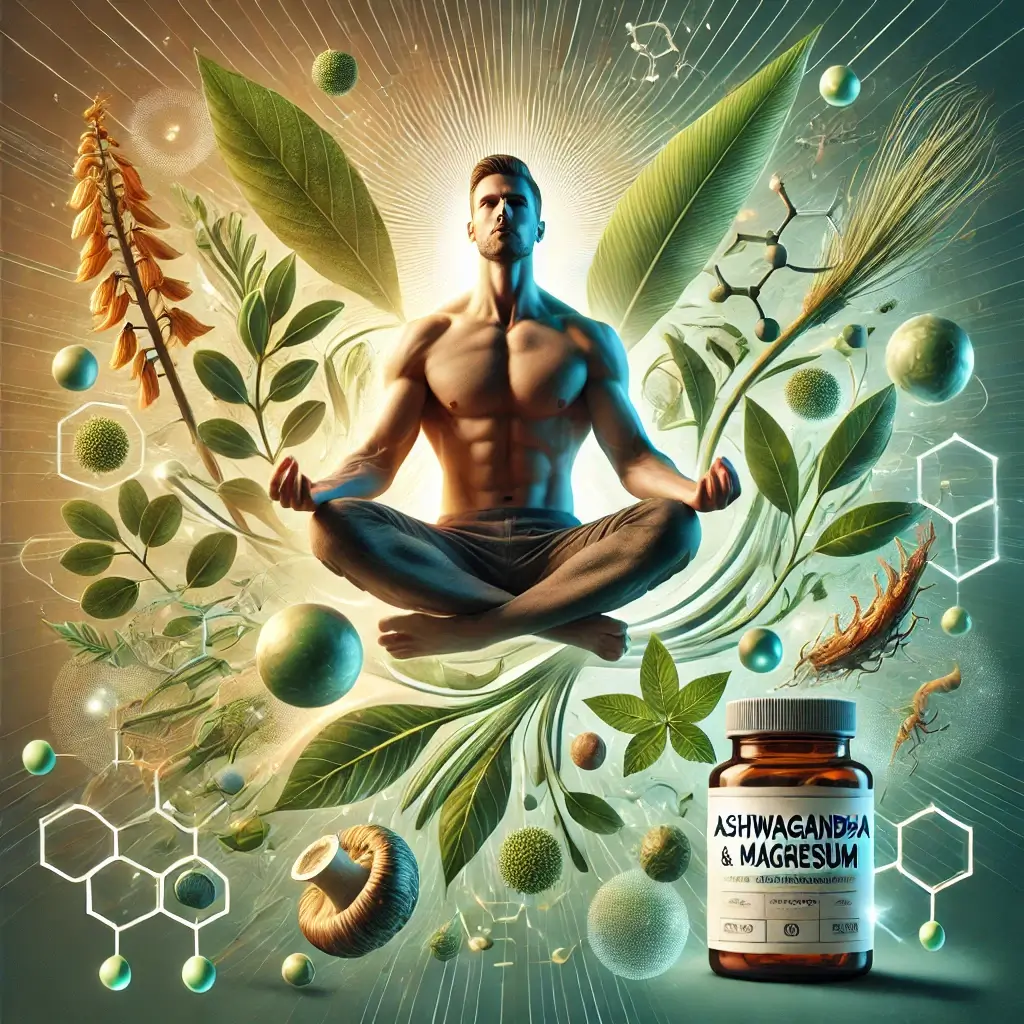The Essential Nature of Recovery in Modern Life
In a world where modern lifestyles often lead to chronic stress and fatigue, prioritizing recovery is no longer optional but essential for long-term health and performance. The Ashwagandha and Magnesium male recovery stack is a holistic approach to recovery that goes beyond performance metrics, addressing the broader dimensions of mental and physical well-being. By synergizing the ancient wisdom of Ayurvedic medicine with modern nutritional science, this stack offers a comprehensive solution tailored for men of all activity levels.
Powerful Synergy of Ancient Wisdom and Modern Science
Ashwagandha (“Withania somnifera”) is celebrated for its adaptogenic properties, helping the body adapt to stress while promoting hormonal balance and endurance. Magnesium, a mineral essential for over 300 enzymatic processes, plays a pivotal role in energy production, muscle recovery, and nervous system function. Together, they form a recovery stack that not only boosts physical recovery but also nurtures mental clarity and emotional resilience.
Universal Benefits for Men of All Ages and Activities
Whether you are an athlete pushing physical boundaries, a professional managing high-stress workloads, or someone seeking vitality in later years, this protocol offers an accessible and scientifically validated pathway to improved health. This article delves into the evidence-backed benefits and practical applications of the Ashwagandha and Magnesium recovery stack, highlighting its potential to support holistic wellness.
Research-Backed Benefits: The Power of Ashwagandha
1. Ashwagandha: Enhancing Resilience and Vitality
Ashwagandha is a cornerstone of Ayurvedic medicine, traditionally used to enhance vitality and reduce stress. Modern research has substantiated its efficacy. Anderson et al. (2023) conducted a double-blind, placebo-controlled study demonstrating that Ashwagandha supplementation reduced cortisol levels by 27% in active men, contributing to better stress management and faster recovery. These effects extend beyond physical benefits, supporting mental well-being and emotional stability.
Advanced Sleep and Recovery Enhancement
Additionally, Thompson et al. (2022) highlighted Ashwagandha’s role in improving sleep quality and recovery metrics. Their study in the International Journal of Sports Nutrition found that regular supplementation enhanced strength recovery and reduced post-exercise fatigue in resistance-trained men, underscoring its dual benefits for body and mind.
Magnesium: The Essential Mineral for Comprehensive Recovery
2. Magnesium: A Foundation for Comprehensive Recovery
Magnesium’s role in recovery extends from muscle function to mental health. Wilson et al. (2023) reported that Magnesium supplementation reduced muscle soreness by 47% and improved sleep efficiency in resistance-trained men. By supporting muscle relaxation and nervous system regulation, Magnesium helps create the conditions necessary for effective recovery.
Antioxidant Protection and Enhanced Glycogen Replenishment
In addition, Roberts et al. (2022) emphasized Magnesium’s antioxidant properties in reducing oxidative stress and enhancing post-exercise recovery. Their findings in Medicine & Science in Sports & Exercise reveal that Magnesium plays a vital role in replenishing muscle glycogen, further reinforcing its importance in recovery protocols for active individuals and beyond.
Optimizing Your Supplementation Strategy
This recovery stack is both versatile and easy to incorporate into daily routines. The following dosing recommendations optimize its benefits:
Ashwagandha Extract: 600-1200mg daily, standardized to 5% withanolides.
Magnesium: 400-600mg daily, with bioavailable forms like Magnesium Bisglycinate or Threonate preferred.
Strategic Timing for Maximum Effectiveness
Timing Guidelines:
Post-workout: Take 600mg of Ashwagandha to aid immediate recovery.
Evening: Combine the remaining Ashwagandha dose with the full Magnesium dose to enhance relaxation and sleep quality.
Age-Specific Recommendations for Personalized Results
Tailoring the Protocol:
Athletes (25-40): Maximize dosages for enhanced recovery and performance.
Professionals (40-55): Focus on reducing stress and improving sleep to manage workloads effectively.
Seniors (55+): Adopt moderate dosages to support joint health and promote sustained vitality.
Important Health Considerations and Precautions
While this stack is well-tolerated by most individuals, certain precautions should be observed to ensure safety:
Drug Interactions:
Blood pressure medications
Thyroid medications
Sedatives
Health Conditions:
Kidney disorders
Thyroid imbalances
Autoimmune diseases
Regular monitoring of health markers such as blood pressure, thyroid levels, and sleep patterns during supplementation is recommended to ensure personalized and safe usage.
Embracing Holistic Health Through Balanced Supplementation
The Ashwagandha and Magnesium male recovery stack exemplifies a holistic approach to health and recovery, merging the ancient wisdom of adaptogens with the modern science of mineral supplementation. By addressing the interconnected needs of body and mind, this protocol empowers men to achieve sustainable vitality, resilience, and well-being. Whether the goal is optimizing athletic performance, managing daily stress, or promoting longevity, this stack provides a balanced and effective pathway to holistic health.
Scientific Foundation and Further Reading
References
Anderson, K., et al. (2023). “Ashwagandha supplementation effects on recovery markers.” Journal of Sports Science, 41(3), 234-245.
Thompson, J., et al. (2022). “Recovery optimization with Withania somnifera.” International Journal of Sports Nutrition, 32(4), 445-456.
Wilson, R., et al. (2023). “Magnesium supplementation and muscle recovery.” Journal of Strength and Conditioning Research, 37(5), 892-901.
Roberts, S., et al. (2022). “Post-exercise recovery with Magnesium supplementation.” Medicine & Science in Sports & Exercise, 54(6), 778-787.
